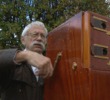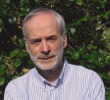John Adderley, Kinematographer/Technician

John Adderley started his career as a cameraman in his native Australia. He came to the UK in 1971 where he has worked extensively for the BBC and other producers. He is experienced in both film and videotape, having been involved with a broad spectrum of programme genres: from school television to drama.
John has always had an interest in historic cameras, owning several hand crank machines from the turn of the 18th/19th centuries. He has used these cameras to make several films, always aiming to stay as close as possible to the techniques used when they were built.
He has the interest, and the analytical and engineering skills, to work out the parameters of all the cameras in the Race to Cinema Collection and has been able to shoot successfully with them. The cameras were of course designed individually using different film formats and, now that film stock is difficult to obtain, John mostly had to cut the film to size using cutters he designed and made himself. The lens angles and apertures were also calculated using special instruments and procedures devised by John. Most of the cameras were originally built before sprockets were invented, so on many occasions the final adjustments could not be made until the camera was finally loaded and ready for shooting!
The frame rates and shutter times were worked out with a light dependent resistor and oscilloscope combination.
In all, great insight was gained into the minds of the inventors plus a real appreciation of the many steps required in the making of modern film production cameras.
Jeff Cousins – Photographer, cinematographer, website producer and researcher on the Race to Cinema Project.

Originally trained as a photographer before moving into the video industry where he has moved through camerawork, editing, producing and directing for broadcast TV, Industry and the Music sector.
Jeff is also a collector of early motion picture cameras ranging from 1898 to the 1960′s and has a keen interest in cinema and the technology used.
Jeff has worked on the Race to Cinema project from the beginning and has visited museums throughout Europe to measure and photograph existing pioneer cameras to assist in the construction of the replica cameras. Jeff has also photographed and produced videos of all the replica pioneer cameras in the Race to Cinema collection as well as managing the Race to Cinema website.
Stephen Herbert, Researcher & Joint Creator of The Race to Cinema Project

Stephen Herbert has been involved with film mechanisms all his life, becoming interested in their workings as a ten-year-old. While employed as a film technician he also researched the history of cinematography, publishing his findings throughout the 1980s and 90s. With privileged hand-on access to many historic movie cameras firstly at the Barnes Museum of Cinematography, and then at London’s Museum of the Moving Image his knowledge grew. While undertaking work on the Trewinnard Collection of original cameras he had the rare advantage of being able to compare published accounts with the actual mechanisms in action which provided invaluable insights.
Stephen has been involved with the Race to Cinema since its inception, providing historical materials for engineer Ivan Rose – including patent drawings and descriptions, little-known original accounts of how the machines worked, and rare photographs. In some cases a meeting with Ivan and Gordon has been necessary, to puzzle over unclear aspects of an intermittent mechanism that needed to be resolved before the new drawings could be made. Stephen learned a lot from Ivan’s engineering experience and intuitive understanding of how the pioneers would have tackled a mechanical challenge, and from both Ivan’s and Gordon’s extensive knowledge of lenses.
Ivan Rose, Engineer for the Race to Cinema Project

Ivan has a 40-year interest in Victorian photography and engineering history, plus 30 years of camera restoration and manufacturing experience, making reproductions of early daguerreotype / wet plate equipment. Engineer Ivan has been responsible for building all 14 of the replica cameras, spending considerable time in thinking mode at the outset in order to fully understand each camera and work out all the numerous stages involved.
His work for each Race to Cinema assignment includes sourcing the wood (sometimes from old furniture – some timber can no longer be obtained new), finding gear cutting companies, suppliers of specialist materials, and founders for the castings, before construction can start. Then work begins on transferring the information shown in the patent, and/or measurements taken from the original cameras where they exist, into working drawings from which the mechanism main frame can commence. Wood patterns are made where special castings are required – iron, bronze and aluminium have all been used. Some of the mechanisms had to be set up on temporary wooden frames to help in initial testing of the alignment.
Finally, after calculating the required optics, suitable period lenses had to be found (usually more than one for each camera, and in one case eighteen!) or more recent lenses adapted. And when each camera was finished (and in many cases a suitable tripod constructed) it had to be tested – initially by Ivan, just to ensure that the film travelled through the mechanism successfully, with the picture as steady as could be expected and in focus. Engineer then becomes photographer, developing the result immediately after exposure.
Being able to rely mainly on just one person, with all of the necessary skills to carry out this work, has been perhaps the main reason why this extraordinary 15-year project has succeeded. It would have been prohibitively expensive to employ a team of engineers / cabinet makers / optical specialists to co-ordinate all of the processes necessary for each complete camera build. With his empathy for the 19th-century materials, Victorian engineering techniques and, of course, the ingenuity of the pioneers, Ivan Rose has triumphed in completing the extraordinary challenge that confronted him
Adrian Denton and all the staff at Christie’s Fine Art Storage Services. London, UK
Alan Birt Acres. London, UK. Grandson of film pioneer Birt Acres. For his time and kind hospitality.
Barbara Heinrich. Polte Bundesarchiv-Filmarchiv. Berlin, Germany. For her supportive professional assistance
Conservatoire National des Arts et Métiers. Paris, France
Eric Lange, Lobster films. Paris, France. For his essential help with the Bouly Camera
Ethan Smith, Henry Smith and Nathanial Smith for assisting in the Jenkins camera test
Film & Photo Ltd laboratories Acton, London, UK. To Tony Scott for his kind help and speedy service
Gerhard Kemner, Deutsches Technikmuseum. Berlin, Germany. For his helpful curatorial cooperation.
John and Bill Barnes film historians, (UK), who offered great encouragement during the early stages of this project and whose magnus opus ‘The Beginnings of Cinema in England 1894- 1901′ was a landmark influence in British cinema history
John Rogers, London, UK. For his beautiful mahogany
Laurent Mannoni, Cinémathèque Française. Paris, France. For his invaluable assistance with the Demeny camera
Luke McKernan The Bioscope website. UK
Michael Harvey, National Media Museum, Bradford, UK. For generous technical assistance and advice
Noot Coates, Bangkok, Thailand. For her beautiful dances
PresTech Film Laboratories. Walthamstow, London, UK. For Joao De Oliveira, Gary Chapman and the rest of a great team for a superb service
Richard Pinches “Meadows Farm Studios” Henley-On-Thames, UK. A very special thanks to you and your crew for helping us bring our Edison film alive at your lovely studios
Russells Photo Imaging. Wimbledon, London, UK. Jane, Dave and all the crew for their skilled assistance
Silverprint Ltd. London, UK. Film and Alternative Photography Specialists – the people who know!
Stephen Barber, Professor at Kingston University, UK. For a very educational tour of the Skladanowsky sights in Berlin
The Director and staff at the Henry Ford Museum. Detroit, USA. For their curatorial hospitality
The Science Museum, London, UK, for assistance with the Friese-Greene stereo camera
Thomas Edison National Historical Park. New Jersey, USA. Joan Harris-Rico, Kevin Daley, Edward Wirth and Leonard deGraaf
Tom Van Dorn, musician and composer, whose inspired composition, “The Music Box” can be heard beautifully complementing some of our films. http://www.cdbaby.com/artist/tomvandorn
Who’s Who of Victorian Cinema (Luke McKernan and Stephen Herbert www.victorian-cinema.net) and all its contributors, for providing the key facts concerning the pioneers who made these fascinating cameras
